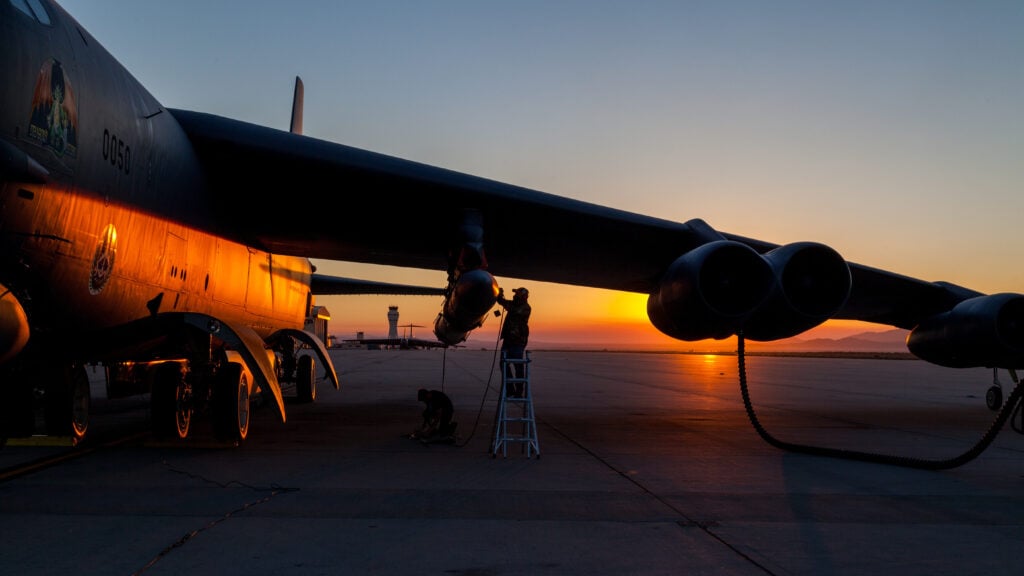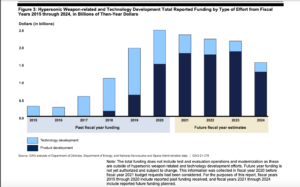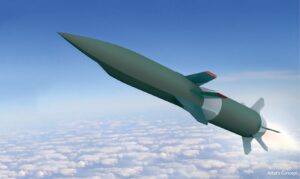
Air-launched Rapid Response Weapon (ARRW), 2020 captive carry test. (Air Force photo by Kyle Brasier)
WASHINGTON: In public comments this week, senior Air Force leaders seem to have soured on the promise of hypersonic missiles, just as the Defense Department is being urged by key lawmakers in the Senate to put more focus on air-breathing hypersonic engine technology.
Air Force Secretary Frank Kendall kicked things off Monday, when he told reporters in the margins of the annual Air Force Association Air, Space & Cyber conference that he is reassessing the Air Force’s hypersonic plans.
“I’m not satisfied with the pace,” he said. “We’re making some progress on the technology; I would like to see it be better.”
Kendall added that he is also “not satisfied with the degree to which we have figured out what we need for hypersonics — of what type, for what missions.”
“The target set that we would want to address, and why hypersonics are the most cost effective weapons for the US, I think it’s still, to me, somewhat of a question mark,” the secretary said. “I haven’t seen all the analysis that’s been done to justify the current program.”
That set the tone for a series of questions to senior uniformed leaders about whether the service remains committed to the current hypersonic roadmap, with a clear theme emerging: Kendall is willing to come in and rip things up if he doesn’t see results.
Gen. Arnold Bunch, the head of Air Force Materiel Command, told reporters on Tuesday that “there are certain aspects, attributes that [have] not performed the way we need to,” while acknowledging that there were always going to be hurdles during development. “We are going to have to continue to put our focus there and we will continue to take what are called educated risks as we move forward so that we can get a capability out in the field as quickly as possible,” he said.
That same day, Lt. Gen. Duke Richardson, the top uniformed acquisition official, said that Kendall has not “spared any program” since he’s come in, taking a critical eye to everything.
“I think he’s seeing the fiscal environment. He wants to make sure that we’re focused on the warfighter — well, really China, right — from the perspective of the warfighter and the taxpayer. And so we’re trying to make sure that we really are laser focused on that. In the case of hypersonics, he wants to understand, again, the use case for that, and so we’re working through that,” Richardson said, adding that Kendall has not ordered any slow-down on either of the service’s main hypersonic test programs.
Finally, on Wednesday, Air Combat Command head Gen. Mark Kelley said he talked with Kendall about the secretary’s comments, and Kelley explained to reporters that Kendall believes “we need a ConOp to make sure we do an acquisition acquisition strategy” that works.
“I think he’s right. We do need to make sure we have an unambiguous, well understood ConOp as we go forward,” Kelly said. “But hypersonics and high end-game maneuvering capability is something we need to keep pursuing. We should make sure before we pull the trigger and commit resources to it everybody’s on the same sheet of music.”
The Air Force leaders’ comments notably come just as key leaders in the Senate are doubling down on their interest in hypersonic weaponry.
The chairman and ranking member of the Senate Armed Services Committee, Sen. Jack Reed, D-R.I., and Sen. Jim Inhofe, R-Okla., in their markup of the 2022 defense policy bill, are pushing hypersonics hard, chiding DoD for going too slow and putting too little focus on air-launched missiles that use scramjets — engines that scoop in and combust oxygen for fuel to bring the missile up to hypersonic speeds of greater than Mach 5.
“The committee is concerned that there is a lack of focus on air-launched and air-breathing hypersonic capability, including the potential for rapid space launch capability facilitated by purpose-built hypersonic aircraft,” states their markup of the National Defense Authorization Act (NDAA) released Wednesday.
Citing hypersonics as an arena of “intense technological competition” with China and Russia, the SASC leaders expressed the need for development of the technology as a “key element of the National Defense Strategy.” The report language goes on, “The committee believes that the Department of Defense (DOD) needs to focus more attention on the expeditious development and maturation of key hypersonic flight technologies.”
The NDAA markup also “directs the Under Secretary of Defense for Research and Engineering, in consultation with the Secretaries of the services, to provide an executable strategy and report to the congressional defense committees, not later than December 30, 2021, on the plan to field air-launched and air-breathing hypersonic weapons and the potential use for tactically responsive launch capabilities within 3 years.”
The markup adds $5 million to the Air Force’s budget request for improved testing facilities, and another $5 million “to support risk reduction and technology maturation through the demonstration of commercial hypersonic flight technologies to support the advancement of reusable hypersonic systems.”
The NDAA report also calls on DoD to beef up ground test facilities, such as wind tunnels, and to accelerate flight testing to mature hypersonic-related technologies in areas such as thermal protection, seekers and communications links.
DoD Investment By The Billions

Investments in hypersonics have soared and shifted from experimentation to prototyping. (GAO)
DoD’s myriad hypersonic projects account for about $15 billion in investment between 2015 and 2024, according to the Government Accountability Office. The Pentagon asked Congress for $2.865 billion for hypersonic weapons in 2021 alone, up not quite 14% from a 2020 total of $2.508 billion.
However, the bulk of current Army, Navy and Air Force research and development dollars — some 56% according to GAO — is primarily being spent on boost-glide technology, which uses a conventional rocket booster full of fuel to accelerate the weapon to hypersonic speed, after which the glide body containing the warhead detaches from the booster and coasts, skipping along the upper limits of the atmosphere.
Boost-glide hypersonic missiles are bigger and heavier than air-breathing ones, and have longer ranges. On the other hand, air-breathing engines are smaller and thus can be used to power cruise missiles that are light enough to be carried by fighter jets — although they also are more technically challenging.
The Air Force is working on development of a highly classified air-launched hypersonic cruise missile called the Hypersonic Attack Cruise Missile (HACM). The service asked for $190.1 million for the effort in its 2022 budget request.
HACM is based on another project the service has been pursuing with DARPA, called Hypersonic Air-Breathing Weapons Concept (HAWC). DARPA requested $10 million for that project in 2022.
A third effort, called Project Mayhem, is also underway but very little is known about the program, which also is known as the Expendable Hypersonic Air-Breathing Multi-Mission Demonstrator Program. Mike White, principal director for hypersonics at DoD’s Research & Engineering office, told the Center for Strategic and International Studies on June 10 that “Project Mayhem is to look at the next step in what the opportunity space allows relative to hypersonic cruise missile systems” and is intended to be capable of flying “significantly longer ranges than what we’re doing today.”
However, those programs are significantly less mature than the Air Force’s major hypersonic R&D effort, the AGM-183A Air-Launched Rapid Response Weapon (ARRW), also being developed in tandem with DARPA.

Hypersonic Air-Breathing Weapons (HAWK), DARPA concept art
ARRW (pronounced arrow) is a hypersonic glide vehicle designed to be carried by a B-52 bomber. The Air Force is seeking about $161 million in fiscal 2022 to produce the first 12 ARRW missiles, on top of some $238.3 million in R&D funds. Lockheed Martin Space is the prime contractor.
So far, that program has been a bit of a bust. ARRW’s failed its first flight test in April. The second booster flight test, on July 28, also failed because the engine failed to ignite, and the service still hasn’t released any information on what caused the problem. Of that failure review board, Richardson this week said the service is “almost close to wrapping it up.”
In an Aug. 4 briefing with reporters, Brig. Gen. Heath Collins, who heads the Air Force Life Cycle Management Center (AFLCMC) Armaments Directorate, said that the program office was still planning for ARRW production to start at the end of fiscal 2022.
Overall, however, Mark Lewis, who formerly spearheaded hypersonic research at DoD’s Office of Research & Engineering, told Breaking Defense that he agrees — vehemently — with SASC’s position, rather than the message coming from the Air Force.
“I’m puzzled that the Air Force might be pulling back, because we had done extensive studies and extensive analysis that demonstrated quite clearly the effectiveness of these systems,” said Lewis, who now heads the National Defense Industrial Association’s new Emerging Technologies Institute (ETI).
“It is obvious that the Chinese don’t have any such misgivings,” he pointedly added.






















